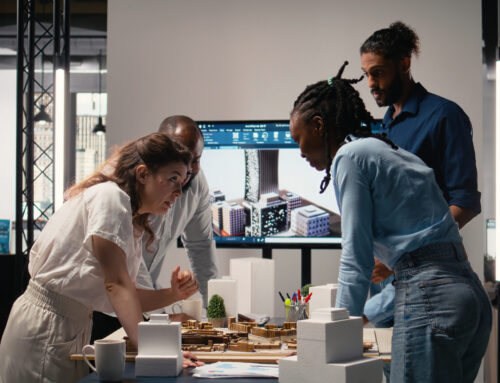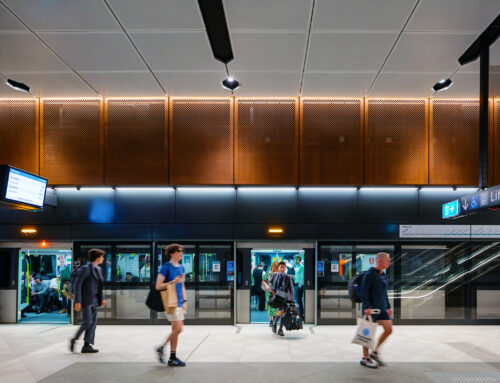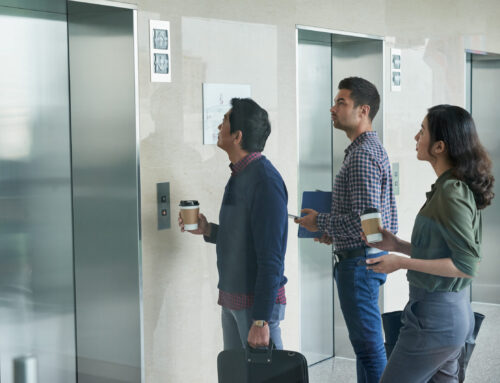A workplace for young talent
Today’s law graduates will be partners 20 years from now. They start their career working in a space that’s been curated by the partners before them – professionals who were the pioneers of pagers, mobile phones and email. Professionals whose view of technology and work was established off the back of technology that had a singular purpose. Technology that has now evolved into connectivity on a much larger scale.
The graduates of today expect technology to just ‘work’. They expect everything ‘right now’. They’ve grown up knowing only stable and reliable smartphones that do everything. To develop a human-centric workplace, we need to gather the aspirational goals that are bursting out of these 20-year-olds. These are the employees that will use a building for its entire life. The workplace we design today needs to work for them and be able to evolve, without a complete re-work, in order to stay relevant.
Designing human-centric Smart Buildings to attract and retain talent
A smart building uses data to improve user experience, operational efficiency and sustainability. By using one common network for access, security, airflow, lighting and day-to-day operations, it’s able to make use of previously untapped information. Integrated technology gathers and blends this information, enabling the system to solve everyday problems for the building’s users, managers and owners.
A smart building uses technology to enable outcomes for all users. This includes the new starter, administrator, business owner, building manager and building owner. By gathering data, and blending it to create useful information and automations, a smart building can create value for everyone.
As engineers, we ask our clients a number of questions before we begin mapping out a smart building solution. How can we make a day easier and more enjoyable for the people who use the building? What everyday problems can we solve? If we can solve users’ daily angst, we can make the office seem like a better place to be than home. We approach all of this with the aim of increasing the value of the building, fostering a culture of hybrid working and maximising its appeal to younger generations.
When we identify these human needs and shape our technology to meet them, we make employees happier. They become more engaged and productive and more likely to stay in the building for longer. True smart buildings step beyond building engineering systems into human-centric design.
The workplace needs of Gen Z
Comfort
The temperature of an office needs to be comfortable for everyone. We can do this by creating a temperature system that respond to employees’ feedback in real time by adjusting the heating or air conditioning. It’s well-known that, on the whole, women feel the cold more than men and prefer warmer temperatures. To have one fixed temperature doesn’t meet everyone’s needs.
The air conditioning in a meeting room can also be programmed to adjust to the number of people attending a meeting – so it winds down if there are only 4 people in an 8-person meeting room. This increases comfort, energy efficiency and the lifetime of the unit. The air conditioning, lights and audio visual can also all be switched on 10 minutes before the start of the meeting, saving time for meeting organisers and administrators.
An employee may want the option to dim the office lighting at the end of the day to match their circadian rhythm or they may want spaces with natural lighting to recharge. These needs are likely to change daily. Contemporary lighting systems now allow this flexibility and can respond to people’s needs in real time.
We can also set up the building to monitor, and report on, air quality and respond to high pollen count or bushfire smoke. Similarly, we can keep track of cleanliness and hygiene and receive notifications when consumables like soap or toilet paper are running low.
Convenience
No-one has enough time to do all the things they want, so let’s buy back some time through smart design.
How about having a coffee ready to pick up from the barista on the ground floor, activated by the card or phone that opened the lobby turnstile while sitting in your pocket? Or imagine the audio-visual switches on 10 minutes before your meeting, prompted by a calendar entry.
We can pull data from existing systems and give it additional purpose, making the day-to-day more seamless for tenants.
Connectivity
Employees want to work from anywhere in the building and still connect to all the systems they need. That might be brainstorming in the outdoor garden space or talking through a brief in the café.
They want to know when the lifts are busy, so they can allow more time to head to a client meeting.
They want to know that a sustainable not-for-profit is presenting in the lobby at midday, so they push a lunch appointment back by 30 minutes.
Community
A new employee might be one of 1,500 in a high-rise office tower and it’s important they don’t feel alone or isolated. Smart technology can help them find their tribe and connect with them over shared interests and values.
A business might release data on the building’s energy performance this week, or how much landfill waste and recycling were generated. Interested employees could use a dedicated tenant app to start conversations about energy and find like-minded colleagues to get involved launching a new energy-saving initiative.
Employees may also want to know if there are other grads coming into the office when they are, so they can book a seat nearby. Or, they may want to know when happy hour is in the bar downstairs so they can reach out to a group of buddies to go along with.
Efficiency
Using people counting, we can know how many people have actually come into the office and turn down or turn off parts of a building that aren’t being used. This has many wins – grouping people into a space where they can collaborate and work more efficiently, reducing energy consumption, extending the life of the plant and aligning building operation with the way people want to use it. That benefits tenants, building managers and owners.
When an administrator books a meeting room at lunchtime, the café below can receive a notification to put together a catering quote for the number of people invited. This saves time and even allows the caterer to receive real time updates on meeting attendees so they can adjust their catering to suit.
Simple ideas that are supported by straightforward technology can make an enormous difference to the perception of an office, shave time off routine tasks and give time back to doing the job that needs to be done.
Productivity
Creating an office where people can work how and where they want is a smart and productive workplace.
Run that workshop at a desk, in the shared meeting space or the garden downstairs and still access the connectivity you need. Human-centric solutions ensure employees don’t lose anything by moving to the place where they’ll find their best self, whatever time or day of the week. They’ll have the same level of control, and even greater potential to do good work.
Listen to Cameron’s summary of this Insight
Collecting the data young people care about
Smart solutions find the data that solves everyday problems and applies logic to positively benefit users of a building. Once a set of data is already being collected, we look at where we can use it to create additional helpful outcomes. An example is calendar entries which we can use to adjust room temperatures and switch on audio visual systems or lighting. By joining one data set with another, we develop the best possible outcomes for people.
The data we can collect falls into four main categories:
- Open-source data from the internet: weather, traffic, transport, food and beverage, retail, events, activities, community.
- Building services data: air-conditioning, lighting, access control, security, CCTV, lifts, escalators.
- Workplace data: audio-visual systems, room bookings, event planning, corporate finance, human resources, wayfinding.
- Sustainability data: air quality, population density, utilities, sustainability ratings.
Choosing technology that has purpose
It’s no longer enough to create a smart building. We need to develop technology solutions that focus on people.
Technology is an enabler and we should only deploy it to add value. It needs to solve problems from day one. Without considering how or why a person would use the building, we risk deploying technology for a single purpose, or no purpose at all.
We can often build additional functionality into a system that already exists to make it more human-centric. For example, CCTV is deployed for security but, wherever a camera is operational, we can people count without the need for an additional sensor. We can then use this data to adjust a building’s energy performance or redeploy under-utilised spaces for higher value activity.
Designing a workplace for people who care about sustainability
At the end of the day, almost everything a smart building can offer a young employee links back to living more sustainably. And we know this is a huge priority for Gen Z. Statistics show that young workers will change jobs because an alternative employer cares more about reducing carbon emissions.
By designing with sustainability in mind, and capturing the right data which a business can report on, building owners and managers become more confident promoting their green credentials in real time.
Showing they care for the planet, and the people who use the building, helps employers and building owners foster engagement and productivity amongst existing talent and build their reputation to appeal to emerging talent. That’s a more successful and sustainable business for everyone.
Future-proofing a smart building for young employees
A smart building, or next-gen building, is based on a technology ecosystem that gathers data and automates workflows at a logical, rather than physical, level. These buildings are based on a design, not a product, and need multiple software products and technology solutions to respond to evolving employee needs and aspirations.
To meet these needs, the design must consider the complexity of the data needed alongside the layers of disparate data sources and languages. Future-proofed design factors these unknowns into its foundations so it can efficiently deploy future technology sets as new data sources and technologies emerge.
Design teams need to understand the balance between the ‘wow factor’ of the very latest shiny technology and the imperative of delivering useful outcomes from day one – for all the occupants of a building, not just the engineering services teams.

Meet our Global Director of Smart Buildings – Cameron Sandell
Having worked in Building Technologies since 1991, Cameron has been exposed to the evolution of HVAC controls, through Building Management Systems (BMS) and now Smart open solutions. The technology capabilities of today mean that data driven business outcomes are no longer limited to the ingestion of only built services but rather allows for the blending of data from enterprise solutions, web services and the built environment to create new insight and automation values.










